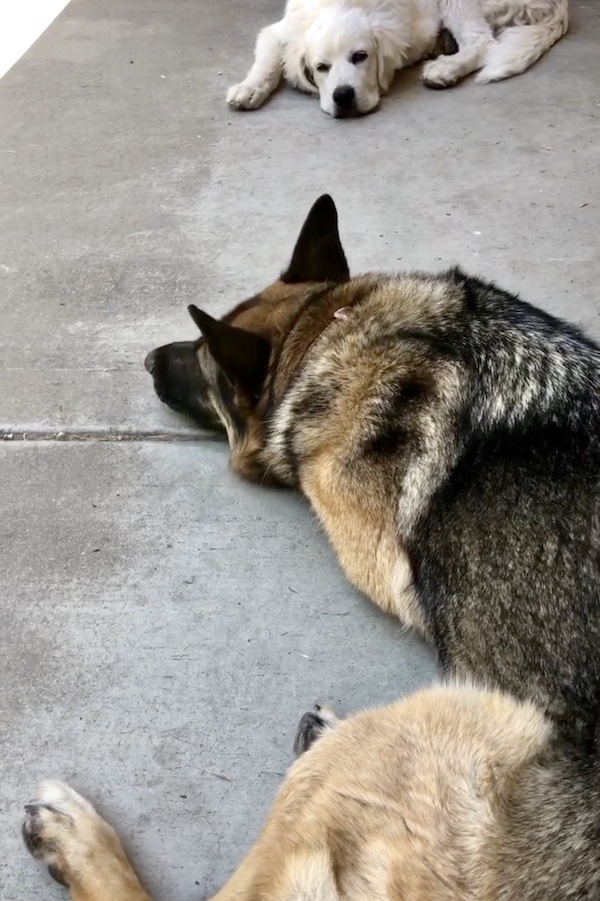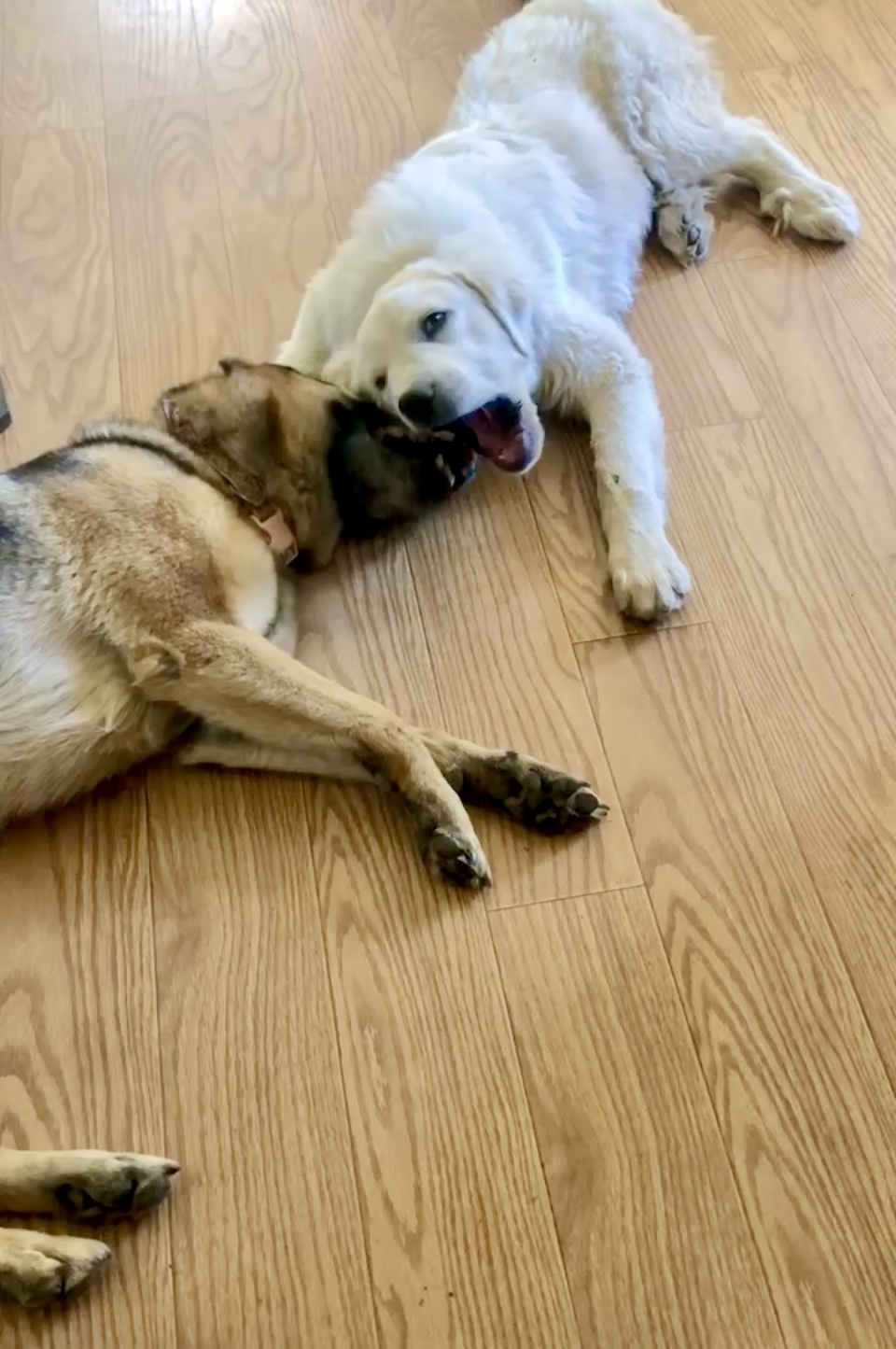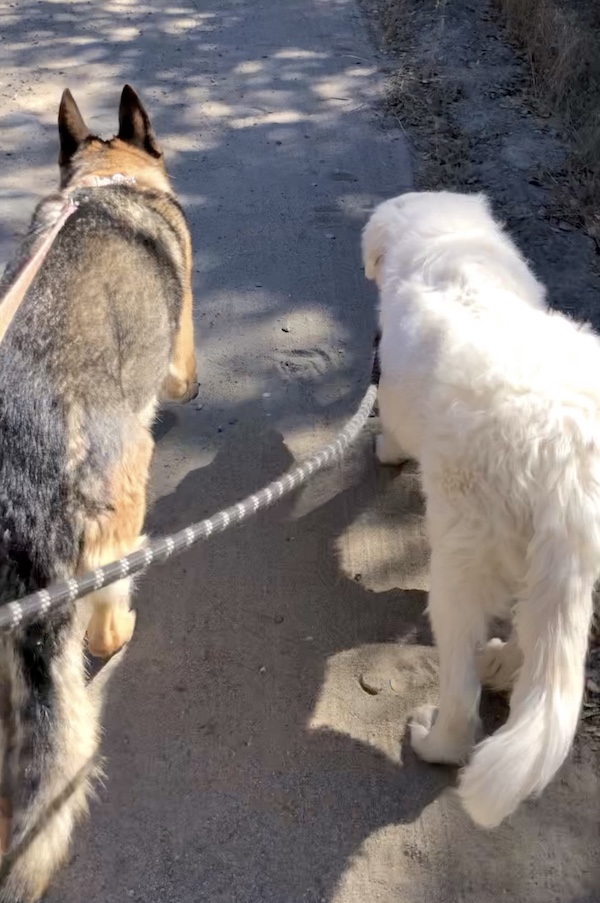Your Dog & New Puppy: Top Tips

I was so worried when I adopted my Great Pyrenees rescue puppy. I didn’t know how my older German Shepherd would react. She has never enjoyed socializing with other dogs and is known to be quite the stinker. Whenever other dogs approach her, especially larger dogs, there is often growling and barking. She shows no indication she wants to be friends with them. I always make sure to keep her on leash if we are going to be around other canines, just to be on the safe side. My worries increased when I read online that German Shepherds and Great Pyrenees do not generally get along. But something told me that I had to try.

I made sure to get a male puppy, since I had learned that often same sex dogs can have issues (although I previously owned two female terriers and had no problems). When I brought Jake home, I initially let Sasha view him from behind a glass door, and of course the aggressive barking ensued. After a few days of this, I brought her out on a leash, and let her get within sniffing distance. She immediately became aggressive and tried to nip at the puppy. My instinct was to yell at her, but this did not help at all. Then I tried some different strategies, and they worked miracles. I am certainly not a professional dog trainer, but I wanted to share what worked for me. Here are my top tips for introducing your dog to a new puppy.
- Use Treats. Sasha’s number one preferred reward is food, so I used treats to help them bond. I would bring Sasha near the puppy on her leash and every time she did not growl at him or get aggressive I gave her a treat. So I was rewarding her for good behavior rather than punishing her for bad behavior. I also gave the puppy treats, and they both were more focused on getting a dog biscuit than anything else. I gradually amped this up to 2-3 times a day, and eventually, the aggressive behavior was extinguished. Keep in mind that these interactions should never be forced. I like petmd.com’s advice to “look for signs that one dog is trying to get away…if your dog runs over to you, don’t send them back ‘into the fire’ because this is usually an indication that your dog needs a break from the interaction”.
- Give your older dog plenty of Love and Attention so he or she does not feel jealous of the new puppy. I continued my routines with Sasha, included one on one throwing her toys for her to fetch. I also brushed her, and gave her lots of petting, praise and kisses.
- Exercise Your Dog and Puppy Together. Jake was not leash trained when I brought him home, but Sasha was used to going for daily walks with me. I purchased a puppy stroller at a thrift store, and used it to take Jake with us until he became leash trained. Initially she tried to nip at him, but he was safely velcroed in the puppy stroller. Eventually, after a few times, she accepted that this was part of our walking routine, and Jake loved watching her lead our team down the road. Now that he is leash trained they trot side by side together. It’s so cute to see Sasha tolerate his frequent displays of affection for her.
- Let Them See Each Other But Keep Them Separated When You Leave. I did not ever leave my dog and puppy alone together for several weeks, just to be on the safe side. I kept Sasha in my mud room, and let her see Jake through the glass doors. You could use a baby gate or crate to separate them too if your older dog is initially hostile. It helps them get used to each other but protects your vulnerable puppy from being hurt. The puppy wanted so badly to play with her, but it wasn’t safe. They were able to develop a bond by seeing each other safely. He now pushes the door open if Sasha is in the mud room to let her into the house!
- Always Let Your Older Dog Have Some Time Alone. If you have ever been the Mom of a toddler, you will know how exhausting it is just maintaining your sanity with all their antics, however cute they may be. You can imagine how it feels for an older dog when there is a puppy, constantly demanding attention from them, jumping on them when they are trying to relax, chewing on their ears, taking their toys, etc. I make sure to let Sasha have time alone, even now when they absolutely adore each other. It enables her to have time alone to do what she wants without Jake’s constant shenanigans. According to the American Kennel Club, you should give your older dog breaks from the puppy several times throughout the day, crating either dog if necessary.
- Make Sure to Get Toys & Bones for Both Dogs. Sasha is very protective of her toys and bones, so I made sure to get extras for the puppy. Jake learned quickly not to take one away from her due to her warning growl. Unfortunately, Sasha will still occasionally steal things from him. If I see her steal Jake’s toy or bone, I simply give him a different one and the issue is resolved.

I hope you found these tips helpful. For more information on this topic, you may want to read these informative articles by AKC and Pet MD. You may also enjoy reading Puppy Love! Favorite Dog Quotes. Thank you for visiting my blog. Wishing you peace, love, and happiness!